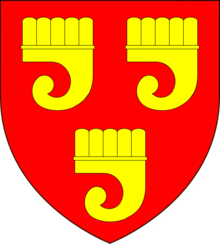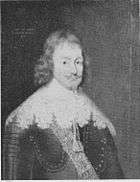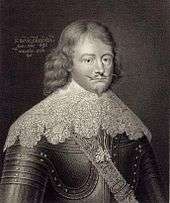Bevil Grenville
Sir Bevil Grenville (23 March 1594/5 – 5 July 1643), lord of the manors of Bideford in Devon and of Stowe in the parish of Kilkhampton, Cornwall, was a Royalist commander in the Civil War. He was killed in action in heroic circumstances at the Battle of Lansdowne in 1643. He served as a Member of Parliament for the county of Cornwall in 1621–1625 and 1640–1642, and for the borough of Launceston in Cornwall, in 1625–1629 and 1640.



Origins
Grenville was born near Withiel, west of Bodmin, Cornwall, the son of Sir Bernard Grenville (1567–1636) of Bideford in Devon and Stowe in the parish of Kilkhampton in Cornwall, by his wife Elizabeth Bevil, daughter and heiress of Philip Bevil and niece and heiress of Sir William Bevil. He was a grandson of Sir Richard Grenville (1542–1591), the heroic Elizabethan naval captain, explorer, and soldier. The Grenville family had for centuries been lords of the manors of Stowe[2] in the parish of Kilkhampton in Cornwall, and of Bideford in Devon.[3]
Education
Grenville was educated at Exeter College, Oxford.[4]
Political career
Grenville was elected Member of Parliament for Cornwall in 1621 and remained so until 1625.[5] Under King Charles I he became MP for Launceston in 1625 where he remained until King Charles I decided to rule without parliament in 1629.[6] In parliament, Grenville supported Sir John Eliot and the opposition, and his intimacy with Eliot was lifelong.[4] In 1639, however, he appeared as a Royalist going to the Bishop's War against Scotland in the train of King Charles. The reason for this change of allegiance is unknown, but Grenville's honour was above suspicion and he must have been convinced that he was doing right. At any rate he was a very valuable recruit to the Royalist cause, being "the most generally loved man in Cornwall."[4] When parliament reassembled for the Short Parliament in April 1640, Grenville was chosen as MP for Launceston again. In November he was re-elected MP for Cornwall for the Long Parliament.[7] He was disabled in 1642 for supporting the Royalists.
Civil War
At the outbreak of the Civil War, Grenville together with others of the gentry not only proclaimed the king's Commission of Array at Launceston assizes, but also persuaded the grand jury of the county to declare their opponents guilty of riot and unlawful assembly, whereupon the posse comitatus was called out to expel them. Under the command of Sir Ralph Hopton, Sir Bevil took a distinguished part in the Battle of Braddock Down and, at Stratton (16 May 1643), where the parliamentarian Henry Grey, 1st Earl of Stamford was completely routed by the Cornishmen. He led one of the storming parties which captured Chudleigh's lines.[8] He then led his men on a victorious march through Devon into Somerset.
Death at Lansdowne
A month later, Hopton's attempt to unite with Prince Maurice and the Marquess of Hertford from Oxford led to the Battle of Lansdowne (1643), which took place near Bath in Somerset. Grenville was killed during the battle on 5 July 1643, at the head of the Cornish infantry as it reached the top of Lansdown Hill.[4] He received a blow to the head with a pole-axe and was taken to the rectory at nearby Cold Ashton where he died.[10] According to the 1911 Encyclopædia Britannica, "His death was a blow from which the king's cause in the West never recovered, for he alone knew how to handle the Cornishmen. Hopton they revered and respected, but Grenville they loved as peculiarly their own commander, and after his death there is little more heard of the reckless valour which had won Stratton and Lansdown."[4]
Marriage and children
He married Grace Smith, a daughter by his second marriage of Sir George Smith (d. 1619) of Madworthy, near Exeter,[12] Devon, a merchant who served as MP for Exeter in 1604, was three times Mayor of Exeter and was Exeter's richest citizen, possessing 25 manors.[12][13][14] Grace's half-sister Elizabeth Smythe was the wife of Sir Thomas Monk (1570–1627) of Potheridge, Devon, MP for Camelford in 1626, and mother of the great general George Monck, 1st Duke of Albemarle, KG (1608–1670). It was largely due to his close kinship to his first cousin the Duke that Sir Bevil's son Sir John Grenville was raised to the peerage in 1660 as Earl of Bath[15] and was also granted the reversion of the Dukedom of Albemarle in the event of the failure of George Monck's male issue.[16] Sir Bevil had by Grace fourteen children, who by Royal Warrant of Precedence were granted the rank and title of Earl's children by King Charles II on 20 August 1675, in recognition of their father's services.[17] Sir Bevil's children adopted a new spelling of the family name as "Granville" in 1661 following the elevation of the eldest son to the peerage as Baron Granville and Earl of Bath. Sir Bevil's children included:[18]
Sons
- Richard Granville (born 1620), eldest son, died unmarried.[18]
- John Granville, 1st Earl of Bath (1628–1701), 2nd son, a major figure in effecting, in a subsidiary role to his cousin George Monck, 1st Duke of Albemarle, the Restoration of the Monarchy to King Charles II in 1660, for which service he was elevated to the peerage. Following his elevation to the peerage in 1661 the family changed the spelling of its surname from Grenville to Granville,[19] to emphasise its supposed origins at Granville, Normandy.
- Rev. Dennis Granville (d. 1702[20]), 3rd son,[18] Dean of Durham Cathedral and chaplain to King Charles II. He was "an unblushing pluralist"[21] and a spendthrift who was publicly arrested for debt in the cloister of Durham Cathedral.[22] His position had been gained through his marriage to a daughter of John Cosin (1594–1672), Bishop of Durham (1660–1672). Like his nephew Lord Lansdown, Dennis followed the Old Pretender into exile, whom he served as chaplain-in-ordinary.[23] He was highly interested in his family's ancestry and by chance made his French residence near Corbeil-Essonnes on the River Seine, which he discovered had been the seat of the ancient "Counts of Corboile", from whom the Grenvilles claimed descent. He claimed to have discovered the tomb of one of the Earls in one of the two churches founded by that family in the town, and used his supposed connection to raise his status amongst the local population.[24] Following the death of his nephew Charles Granville, 2nd Earl of Bath in 1701, in 1702 he started signing himself in correspondence as Corbeil or de Corbeil, and applied to the King of France for preferment due to "discovering my descent from the Kings of France".[25] His hopes were disappointed. Following the death of the Old Pretender in 1701 his son the Young Pretender allowed Dennis a salary as a domestic servant. Dennis died the following year in 1702.
- Bernard Granville, 4th son (1631–1701),[18] father of George Granville, 1st Baron Lansdown (1666–1735). George became heir male of the family on the extinction of the senior male line in 1711, following the death of William Granville, 3rd Earl of Bath (1692–1711), and due to this in 1712 was raised to the peerage as "Baron Lansdown of Bideford".[26] However George died without male issue leaving only daughters, when the new title became extinct. Baron Lansdown erected two monuments to his grandfather Sir Bevil, one being the monument on Lansdown Hill, the other being a mural monument in the Granville Chapel in the Church of St James the Great, Kilkhampton."[9] As a Jacobite Lord Lansdown was imprisoned in the Tower of London between 1715 and 1717 during the reign of King George I (1714–1727) and in 1721 followed into French exile the Old Pretender, who granted him several titles of nobility,"[27] none of which had legal status in the Kingdom of Great Britain.
Daughters
- Elizabeth Granville, eldest daughter,[18] wife of Sir Peter Prideaux, 3rd Baronet (1626–1705), of Netherton in the parish of Farway, Devon, MP for Liskeard, Cornwall, in 1661.[28]
- Bridget Granville, 2nd daughter, wife of Sir Thomas Higgins.[18]
- Johanna Granville, 3rd daughter, wife of Col. Richard Thornhill.[18]
- Grace Grenville, 4th daughter,[18] who on 20 February 1645 at Kilkhampton married (as his 1st wife) Col. Robert Fortescue (1617–1677) (second son of Hugh Fortescue (1593–1663) of Filleigh, Devon, ancestor of Earl Fortescue)[29] Robert Fortescue erected a mural monument in the parish church of Ebrington in Gloucestershire to his six-times great-grandfather Sir John Fortescue (c. 1394 – c. 1480), Chief Justice of the King's Bench, on which are displayed the arms of Grenville.[30]
Character
According to the Encyclopædia Britannica Eleventh Edition: "Grenville was the type of all that was best in royalism. He was neither rapacious, drunken nor dissolute, but his loyalty was unselfish, his life pure and his skill no less than his bravery unquestionable."
Death and burial

Following his mortal wounding at the Battle of Lansdown and his death later that day of 5 July 1643 in the rectory at Cold Ashton in Gloucestershire, his giant servant Anthony Payne, about whom Alan M. Kent wrote a poem Oogly es Sin: the Lamentable Ballad of Anthony Payne, Cornish Giant,[31] brought his body back to Kilkhampton in Cornwall,[32] where he was buried in the parish church of St James the Great. His Cornish soldiers refused to fight under any other leader and returned home.[33]
Monuments
There is a portrait miniature of Grenville in the Waddesdon Bequest in the British Museum.[34]
Mural monument, Kilkhampton Church

A mural monument to Sir Bevil Grenville in the Granville Chapel in Kilkhampton parish church, Cornwall, was erected in 1714 by his grandson George Granville, 1st Baron Lansdown (1666–1735).[9] The main inscription reads:
- "Here lyes all that was mortall of the most noble & truly valiant Sr Bevill Granville of Stowe in the county of Cornwall, Earl of Corbile & Lord of Thorigny & Granville in France & Normandy, descended in a direct line from Robert second son of ye warlike Rollo first Duke of Normandy who after having obtained diverse signall victoryes over ye rebells in ye West was at length slain with many wounds at the Battle of Lansdowne July ye 5th 1643. He was born ye 23d day of March 1595 and was deposited with his noble & heroick ancestors in this church ye 26th of July 1643. He marry'd the most virtuous lady Grace daughter of Sr George Smith of ye county of Devon by whom he had many sons eminent for their loyalty & firm adherence to ye crown & church and severall daughters remarkable examples of true piety. He was indeed an excellent person whose activity interest & reputation was ye foundation of what had been done in Cornwall & his temper & affections so public that no accident which happen'd could make any impressions in him and his example kept others from taking any thing ill or at least seeming so to do. Inamor'd a brighter courage & a gentler disposition were nevar marry'd together to make ye most chearfull & innocent conversation. Vid. Earl of Clarendon's History of ye Rebellion. To ye immortall memory of his renown'd grandf'ther this monument was erected by ye Right Hon.bl George Lord Lansdowne, Treasurer of ye Household to Queen Anne & one of Her Majesty's most Hon.ble Privy Counsel & in ye year of Our Lord 1714"
Underneath on a smaller tablet is the following inscription with verse by Martin Lluelyn (1616–1682), a fellow Royalist captain and a poet and physician, published in 1643:
"Thus slain thy valiant Ancestor did ly
When his one bark a navy did defy
When now encompas't round the victor stood
And bath'd his pinnace in his co'quering blood
Till all his purple current dry'd and spent
He fell and made the waves his monument
Where shall ye next fam'd Granvill's ashes stand
Thy grand syre fills the seas and thou ye landMartin L. Lewellin. Vid. Oxford University Verses printed 1643"
Sir Bevil Grenville's Monument, Lansdown Hill
Sir Bevil Grenville's Monument was erected in 1720 also by his grandson George Granville, 1st Baron Lansdown (1666–1735).[9] It is situated on top of Lansdown Hill[4] to commemorate his heroism and that of his Cornish pikemen at the Battle of Lansdown.
See also
Sources
- Burke, John, Genealogical and Heraldic History of the Commoners of Great Britain and Ireland, Vol.3, 1836, pp. 3–7, Granville of Calwich Abbey (complete pedigree of Granville family)
Notes
- Delderfield 1968, p. 123.
- Cleveland, Duchess of (Catherine Powlett), The Battle Abbey Roll with some Account of the Norman Lineages, 3 vols., London, 1889 Archived 23 February 2013 at Archive.today
- Hoskins, W.G., A New Survey of England: Devon, London, 1959 (first published 1954), p. 336
-

- Willis 1750, pp. 176, 188, 198.
- Willis 1750, pp. 209, 219.
- Willis 1750, pp. 230, 241.
- Chisholm 1911, p. 580 cites Clarendon, vii., 89
- Round, p. 142
- Barratt 2005, pp. 53–56.
- Pole, Sir William (d.1635), Collections Towards a Description of the County of Devon, Sir John-William de la Pole (ed.), London, 1791, p. 502
- Vivian, Lt.Col. J.L., (Ed.) The Visitations of the County of Devon: Comprising the Heralds' Visitations of 1531, 1564 & 1620, Exeter, 1895, p. 569, pedigree of Monk of Potheridge
- Yerby, George & Hunneyball, Paul, biography of George Smith (d.1619) of Madford House, Exeter, published in The History of Parliament: the House of Commons 1604–1629, ed. Andrew Thrush and John P. Ferris, 2010
- J. Horace Round, Family Origins and Other Studies, ed. Page, William, 1930, p. 164, The Granvilles and the Monks
- Round, p. 163: "Great as was the favour bestowed on Sir John Granville" (i.e. later cr. 1st Earl of Bath) "and his brothers under Charles II, the actual part taken by Sir John in the restoration of the King was less potent to obtain it than his lucky relationship to George Monk, the prime agent in that event"
- Round, p. 165
- "No. 1020". The London Gazette. 30 August 1675. p. 2.
- Burke, 1836
- Round, J. Horace, Family Origins and Other Studies, London, 1930, The Granvilles and the Monks, pp. 130–169, p. 130 (1661, the time of the elevation of John Grenville to the Earldom of Bath)
- Round, p. 149
- Round, p. 143
- Round, p. 144
- Round, p. 145
- Round, p. 147
- Round, p. 148
- Round, p. 141
- Round, pp. 141–2, Jacobite titles
- Vivian, Lt.Col. J.L., (Ed.) The Visitations of the County of Devon: Comprising the Heralds' Visitations of 1531, 1564 & 1620, Exeter, 1895, p. 622, pedigree of Prideaux
- Vivian, Lt.Col. J.L., (Ed.) The Visitations of the County of Devon: Comprising the Heralds' Visitations of 1531, 1564 & 1620, Exeter, 1895, p. 355, pedigree of Fortescue
- Transactions of The Bristol & Gloucestershire Archaeological Society, vol.25, 1902, p. 200
- BBC staff (8 January 2008). "Anthony Payne: a one man stage play written by Dr Alan M Kent". BBC.
- Mee, Arthur (1937). Cornwall. London: Hodder & Stoughton. pp. 98–99.
- Stoyle, Mark (2002). West Britons. University of Exeter Press.
- British Museum collection database
- Pole, Sir William (d.1635), Collections Towards a Description of the County of Devon, Sir John-William de la Pole (ed.), London, 1791, p. 502. Much of the gilding on the martlets has worn off, making them appear as argent
References
- Barratt, John (2005). The civil war in the south west. Bernsley: Pen & Sword Military. pp. 53–56. ISBN 1-84415-146-8.CS1 maint: ref=harv (link)
- Delderfield, Eric R. (1968). West Country Historic Houses and their Families:Cornwall, Devon and West Somerset. 1. Newton Abbot Newton Abbot: David and Charles. p. 123.CS1 maint: ref=harv (link)
- Willis, Browne (1750). Notitia Parliamentaria, Part II: A Series or Lists of the Representatives in the several Parliaments held from the Reformation 1541, to the Restoration 1660 ... London. pp. 176, 188, 198, 209, 219, 230, 241.CS1 maint: ref=harv (link)
Further reading
- Firth, C. H. (1890). . In Stephen, Leslie; Lee, Sidney (eds.). Dictionary of National Biography. 23. London: Smith, Elder & Co. pp. 110–112.
- Duffin, Anne. "Grenville, Sir Bevil (1596–1643)". Oxford Dictionary of National Biography (online ed.). Oxford University Press. doi:10.1093/ref:odnb/11487. (Subscription or UK public library membership required.)
- Lloyd (1668). Memoirs of Excellent Personages.
- Gardiner, S. R. History of the English Civil War: (1642–1644). 1. pp. 80, 81 99 100 160 200–202. (Gardiner spells Grenville "Sir Bevil Grenvile")
- "Battlefield History Resources". Archived from the original on 5 September 2011. Retrieved 1 April 2009.
| Parliament of England | ||
|---|---|---|
| Preceded by Richard Carew John St Aubyn |
Member of Parliament for Cornwall 1621–1625 With: John Arundell 1621–1622 William Coryton 1624–1625 |
Succeeded by Sir Robert Killigrew Charles Trevanion |
| Preceded by Sir Francis Crane Miles Fleetwood |
Member of Parliament for Launceston 1625–1629 With: Richard Scott |
Succeeded by Parliament suspended until 1640 |
| Preceded by Parliament suspended since 1629 |
Member of Parliament for Launceston 1640 With: Ambrose Manaton |
Succeeded by Ambrose Manaton William Coryton |
| Preceded by William Godolphin Richard Buller |
Member of Parliament for Cornwall 1640–1642 With: Alexander Carew |
Succeeded by Hugh Boscawen Nicholas Trefusis |